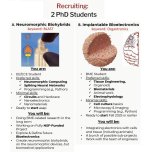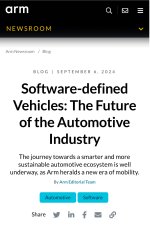Apologies if posted . Interesting listen via YouTube link below
The automotive technology landscape is currently at a pivotal juncture, with its future in dynamic and adaptable systems that allow for continuous improvements to the driving experience through software.
Today, up to 650 million lines of code are in a modern car; for comparison, there are 15 million lines of code in a Boeing 737. This number will only grow further in the future and this transformation will revolutionize how drivers interact with their vehicles and redefine the relationship between vehicle manufacturers and owners.
What is a software-defined vehicle?
A
software-defined vehicle (SDV) is a cohesive blend of hardware and software that enables a smoother interaction between a vehicle’s internal systems and the outside world. SDVs decouple network functions from proprietary hardware, allowing for parallel physical and digital development. This shift enables software to drive differentiation and commercialize vehicle functionalities, maximizing the lifecycle and value of vehicles.
As the automotive industry advances towards SDVs, the roles of vehicle manufacturers, software developers, and other stakeholders will transform. Their collaboration will lead to the creation of smarter, more efficient vehicles that cater to the evolving needs of drivers.
The integration of automotive software with advanced connectivity, artificial intelligence (AI), and user interfaces will further enhance SDV capabilities, ushering in a new era of safer, more sustainable, and enjoyable vehicles.
Top 7 benefits of software-defined vehicles
- Preventative maintenance: SDVs leverage real-time performance insights to enable predictive maintenance, reducing unexpected breakdowns and extending vehicle lifespan. This proactive approach can cut maintenance costs by up to 10 to 20 percent for the end-user.
- Reduced manufacturing costs: In SDVs, various vehicle functions are integrated into fewer chips, eliminating the need for multiple, separately sourced chips and silicon. SDVs are also expected to create over USD 650 billion in value for the automotive industry by 2030, accredited to reduced software R&D and development costs.
- Enhanced safety: Advanced Driver Assistance Systems (ADAS) is estimated to prevent up to 44 million crashes and 300,000 fatalities in the U.S. by 2050. The flexibility delivered by SDV technology can allow ADAS to evolve even more. These advancements can not only enhance individual vehicles but also reduce road accidents and fatalities, representing a major milestone on the path to fully autonomous driving.
- Over-the-Air (OTA) updates: OTA updates allow vehicle manufacturers to deliver new features, fix bugs, and enhance security remotely. This ensures vehicles remain up-to-date and functional, with some manufacturers providing monthly updates.
- Comfort and experience: Connected onboard infotainment systems in SDVs offer personalized music, video streaming, navigation, and climate control, adding to the state-of-the-art driving experience. It will open doors to highly adaptable and personalized driving experiences that address shifting preferences and consumer demands.
- Smartphone integration: Seamless smartphone integration allows for remote start, lock/unlock, and vehicle status checks. Some applications can also provide real-time traffic updates and personalized navigation.
- Real-time connectivity: SDVs support vehicle-to-everything (V2X) communication, enabling real-time data exchange, navigation assistance, and remote diagnostics, which improves the efficiency and safety of driving.
How is Arm leading the software-defined vehicle revolution?
Arm has been at the forefront of the SDV revolution, offering essential technologies for automotive applications that are needed to make SDVs a reality. Our
Automotive Enhanced (AE) IP portfolio, which includes Cortex-A, Cortex-M, and Cortex R CPUs, Mali GPUs, as well as ISPs, with in-built functional safety features, forms the backbone of many automotive computing solutions for SDVs.
Key innovations and initiatives by Arm for SDVs include:
- High-performance processors: The latest Armv9-based AE IP processors enhance security and performance in SDVs, featuring advanced security tools like Branch Target Identification (BTI), Pointer Authentication (PAC), and Memory Tagging Extension (MTE).
- Scalable platforms: Arm’s scalable platforms support a wide range of automotive applications, from ADAS to in-vehicle infotainment (IVI), enabling seamless integration and upgradability.
- Ecosystem collaborations and initiatives: Arm collaborates with numerous automotive manufacturers and technology companies to advance SDV technologies. These partnerships are crucial for accelerating the development and deployment of SDVs.
- Comprehensive solutions: Arm is working with a wide range of partners, including Amazon Web Services (AWS) and Tata Technologies, to deliver comprehensive solutions for SDVs. These collaborations focus on integrating advanced technologies and ensuring that SDVs meet the highest standards of performance, safety, and security.
- Virtual platforms: Arm and our partners including Cadence, Corellium and Siemens have developed virtual platforms that allow for the early evaluation and development of software without needing physical silicon. This significantly reduces the time-to-market for new automotive technologies.
- SOAFFEE: The Scalable Open Architecture for Embedded Edge (SOAFEE) is a collaborative effort with leaders across the automotive supply chain to create a standardized software architecture for SDVs. This initiative aims to streamline development processes and enhance interoperability across the industry.
The future of automotive is being built on Arm
The shift towards SDVs represents a transformative leap in the automotive industry. With advanced software capabilities and robust hardware, SDVs can significantly enhance safety, reduce costs, and provide a more personalized and connected driving experience.
Arm’s technological marvels, initiatives, and collaborations are paving the way for a new era of automotive innovation, where vehicles are not just modes of transport but sophisticated, software-driven platforms that offer enhanced user experiences and capabilities.







